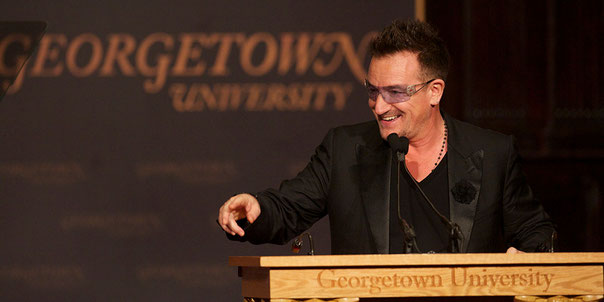
Have you ever seen Bono speak? We all know him as the front man for the rock band U-2, but did you know he is an
outstanding public speaker? Bono isn’t just good; he’s absolutely phenomenal. Not because he’s famous, but because he applies techniques we can all use.
Bono takes time to connect.
He spends considerable time at the front end of his speech connecting with his audience. He’ll thank his host, crack a quick joke at his own expense and provide a personal insight. He sometimes asks a question that’s on everyone’s mind. At the National Prayer Breakfast he asked, “If you're wondering what I'm doing here, at a prayer breakfast, well, so am I.” Imagine yourself in the crowd with your arms folded across your chest wondering it too. It’s totally disarming. This upfront self-deprecation and acknowledgment of a supposed credibility gap actually increases his trustworthiness, breaks down barriers and sets the stage for a great speech.
Bono knows his audience.
Know your audience is a speaking maxim and Bono takes it seriously. It’s obvious he prepares ahead of time and in doing so this helps him connect with his audience further still. When he addressed the student body at Georgetown University, he referenced local pubs and student hangouts. Additionally, he poked a bit of fun at the university’s administration. Because he showed he cared enough to learn this inside information he gained additional credibility.
Bono tells personal stories.
Telling personal stories is an excellent way to connect with an audience because it lets them in. Furthermore, they’re easy to remember and they’re easy to tell using a conversational tone. Bono weaves in personal, humble stories from his life, not his rock star life, but his personal life. This is powerful.
Bono inspires.
He talks about lofty ideals like justice, the end to poverty and solving world hunger. And while he may dabble in the specifics at the tactical level he always ties these examples back to the larger more strategic picture. The trivial can interest, but the grand inspires. Finally, Bono puts the inspiration to good use with a motivational closing call to action.
He isn’t the only speaker who uses these techniques, in fact many great speakers follow this very pattern, Bono’s just one of the best. We can learn a lot from him.
Have other ideas on how to give a great speech? Leave a comment and join the conversation.
******************************************************************************************
Paul McGillicuddy has over 10 years of executive-level leadership experience and is working as an independent consultant.
Want to discuss ideas or connect?
Phone: 916-899-7348
pandmj@gmail.com
Twitter @phmcgillicuddy
Instagram @bnwpicks
LinkedIn: https://www.linkedin.com/in/paulmcgillicuddypresidentcoo

Write a comment